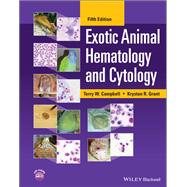The newly revised Fifth Edition of Exotic Animal Hematology and Cytology delivers a fully updated new edition of the most complete reference to hematology and cytology in exotic animals. The book features high-quality images and step-by-step descriptions of practical techniques.
Organized by animal class to make it easier to quickly find critical information, the authors have included 45 new case studies to highlight the application of the content in a real-world setting. All major exotic animal groups are covered, including mammals, birds, reptiles, amphibians, and fish.
Clinicians seeking a decision-making aid for patient workup, treatment, and prognosis will find what they need in Exotic Animal Hematology and Cytology. The book also includes:
- Thorough cellular descriptions unique to mammalian, avian, herptile, and fish species, with extensive discussions of blood and bone marrow sample collection and hematologic techniques for each group
- Comprehensive evaluation of the peripheral blood specific to mammals, birds, herptiles, and fish, as well as the evaluation of bone marrow
- Practical discussions of hematology case studies with applications to common real-world clinical problems
- Color atlas of hemic cells of select species for quick and easy reference
- Extensive examinations of cytodiagnosis and exploration of unique features within mammals, birds, herptiles, and fish, as well as cytology case studies and wet-mount cases in fish
- Access to video clips and additional case reports on a companion website
Exotic Animal Hematology and Cytology is an essential reference for veterinary clinical pathologists, anatomic pathologists, clinicians, and technicians, as well as for veterinary students taking courses involving exotic hematology and cytology.









